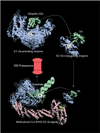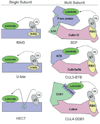The ubiquitin-proteasome system regulates plant hormone signaling
- PMID: 20409276
- PMCID: PMC3066055
- DOI: 10.1111/j.1365-313X.2010.04112.x
The ubiquitin-proteasome system regulates plant hormone signaling
Abstract
Plants utilize the ubiquitin-proteasome system (UPS) to modulate nearly every aspect of growth and development. Ubiquitin is covalently attached to target proteins through the action of three enzymes known as E1, E2, and E3. The ultimate outcome of this post-translational modification depends on the nature of the ubiquitin linkage and the extent of polyubiquitination. In most cases, ubiquitination results in degradation of the target protein in the 26S proteasome. During the last 10 years it has become clear that the UPS plays a prominent regulatory role in hormone biology. E3 ubiquitin ligases in particular actively participate in hormone perception, de-repression of hormone signaling pathways, degradation of hormone specific transcription factors, and regulation of hormone biosynthesis. It is certain that additional functions will be discovered as more of the nearly 1200 potential E3s in plants are elucidated.
Figures



Similar articles
-
Ubiquitin ligases mediate growth and development by promoting protein death.Curr Opin Plant Biol. 2007 Dec;10(6):624-32. doi: 10.1016/j.pbi.2007.07.010. Epub 2007 Sep 11. Curr Opin Plant Biol. 2007. PMID: 17851112 Review.
-
Ubiquitin-Proteasome System in ABA Signaling: From Perception to Action.Mol Plant. 2016 Jan 4;9(1):21-33. doi: 10.1016/j.molp.2015.09.015. Epub 2015 Oct 9. Mol Plant. 2016. PMID: 26455462 Review.
-
[Ubiquitin-proteasome system and sperm DNA repair: An update].Zhonghua Nan Ke Xue. 2016 Sep;22(9):834-837. Zhonghua Nan Ke Xue. 2016. PMID: 29071883 Review. Chinese.
-
E3 ubiquitin ligases and abscisic acid signaling.Plant Signal Behav. 2011 Mar;6(3):344-8. doi: 10.4161/psb.6.3.13914. Epub 2011 Mar 1. Plant Signal Behav. 2011. PMID: 21364320 Free PMC article. Review.
-
The Role of E3 Ubiquitin Ligase Gene FBK in Ubiquitination Modification of Protein and Its Potential Function in Plant Growth, Development, Secondary Metabolism, and Stress Response.Int J Mol Sci. 2025 Jan 19;26(2):821. doi: 10.3390/ijms26020821. Int J Mol Sci. 2025. PMID: 39859535 Free PMC article. Review.
Cited by
-
Advanced proteomic analyses yield a deep catalog of ubiquitylation targets in Arabidopsis.Plant Cell. 2013 May;25(5):1523-40. doi: 10.1105/tpc.112.108613. Epub 2013 May 10. Plant Cell. 2013. PMID: 23667124 Free PMC article.
-
Hijacking of the Host SCF Ubiquitin Ligase Machinery by Plant Pathogens.Front Plant Sci. 2011 Nov 22;2:87. doi: 10.3389/fpls.2011.00087. eCollection 2011. Front Plant Sci. 2011. PMID: 22645554 Free PMC article.
-
Singlet oxygen- and EXECUTER1-mediated signaling is initiated in grana margins and depends on the protease FtsH2.Proc Natl Acad Sci U S A. 2016 Jun 28;113(26):E3792-800. doi: 10.1073/pnas.1603562113. Epub 2016 Jun 14. Proc Natl Acad Sci U S A. 2016. PMID: 27303039 Free PMC article.
-
Characterization and regulation mechanism analysis of ubiquitin-conjugating family genes in strawberry reveals a potential role in fruit ripening.BMC Plant Biol. 2022 Jan 19;22(1):39. doi: 10.1186/s12870-021-03421-8. BMC Plant Biol. 2022. PMID: 35045827 Free PMC article.
-
Regulatory roles of selective autophagy through targeting of native proteins in plant adaptive responses.Plant Cell Rep. 2022 Nov;41(11):2125-2138. doi: 10.1007/s00299-022-02910-w. Epub 2022 Aug 3. Plant Cell Rep. 2022. PMID: 35922498 Review.
References
-
- Amador V, Monte E, Garcia-Martinez JL, Prat S. Gibberellins signal nuclear import of PHOR1, a photoperiod-responsive protein with homology to Drosophila armadillo. Cell. 2001;106:343–354. - PubMed
-
- Bernhardt A, Lechner E, Hano P, et al. CUL4 associates with DDB1 and DET1 and its downregulation affects diverse aspects of development in Arabidopsis thaliana. Plant J. 2006;47:591–603. - PubMed
-
- Biswas KK, Oorua C, Higuchi K, et al. Genetic characterization of mutants resistant to the antiauxin p-chlorophenoxyisobutyric acid reveals that AAR3, a gene encoding a DCN1 like protein, regulates reponses to the synthetic auxin 2′4-dichlorophenoxyacetic acid in Arabidopsis roots. Plant Physiol. 2007;145:773–785. - PMC - PubMed
-
- Browse J. Jasmonate: an oxylipin signal with many roles in plants. Vitam. Horm. 2005;72:431–456. - PubMed
Publication types
MeSH terms
Substances
Grants and funding
LinkOut - more resources
Full Text Sources
Other Literature Sources

